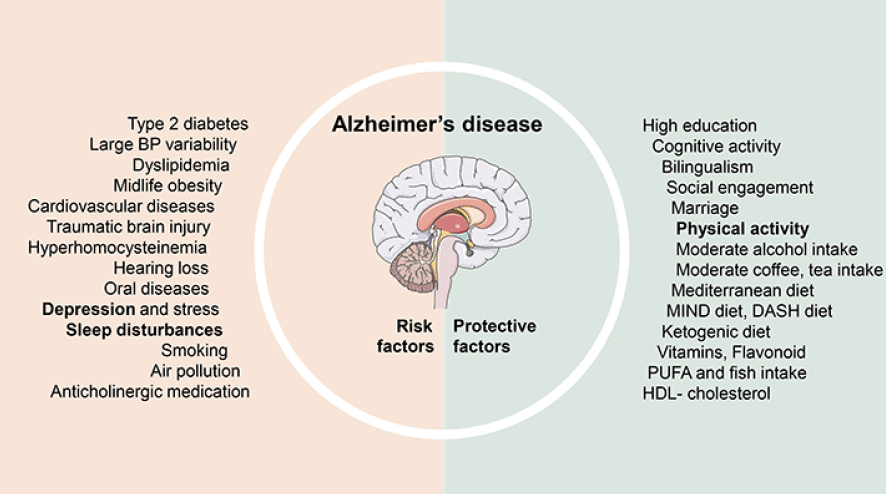Combination of NMN, Probiotic, and Prebiotic Reduce Alzheimer’s Brain Plaques by 67%
Oral supplementation of NMN, L. plantarum, and lactulose reduces gut inflammation and brain plaques in Alzheimer’s model mice.
Highlights:
- The NMN, L. plantarum, and lactulose combo reduces Alzheimer’s plaques in regions of the brain associated with consciousness, thinking, and memory.
- Previous studies suggest that NMN, L. plantarum, and lactulose could work synergistically to improve cognition.
In addition to progressive memory loss, cognitive decline, and neurodegeneration, Alzheimer’s disease (AD) features the abnormal accumulation of amyloid-β (Aβ) peptides. These peptides can form plaques in brain regions associated with cognition and memory. Moreover, some scientists believe Aβ plaques drive the progression of AD.
Now, researchers from the University of Jinan in China show that combining NMN, L. plantarum, and lactulose reduces Aβ plaque burden in a mouse model of AD. They show this in the cerebral cortex — the brain region associated with consciousness, thinking, and memory — and the hippocampus — the brain region associated with consolidating memories. Aβ plaque burden was reduced by 67% in the cerebral cortex and 60% in the hippocampus.

The NMN combo also reduced inflammation in the colon of the AD mice while improving the colon wall’s absorptive capacity. Furthermore, the combo reduced reactive oxygen species (ROS) levels in the colon, cerebral cortex, and hippocampus. Reducing ROS levels can mitigate oxidative stress, a key driver of cellular aging. Overall, these findings demonstrate that combining NMN, L. plantarum, and lactulose can ameliorate AD pathology and improve gut health in mice harboring human AD-associated genes (APP/PS1 mice).
All Three Interventions Improve Cognition
On their own, NMN, L. plantarum, and lactulose improve cognition, according to rodent studies. Furthermore, synergistic effects have been reported between probiotics and prebiotics, as well as NMN and prebiotics. With this in mind, the doses of NMN, L. plantarum, and lactulose used in the University of Jinan researcher’s NMN combo could potentially improve the learning and memory of rodents with cognitive impairment.
NMN
The NMN combo contains 300 mg/kg of NMN, the human equivalent of about 1.5 g of NMN for someone who weighs 170 pounds. Previously, injections of 100 mg/kg of NMN were shown to improve the cognition of AD mice. While oral administration reduces the amount of NMN that makes it to the bloodstream, a 300 mg/kg dose could have similar results on cognition.
L. plantarum
L. plantarum is a probiotic, a beneficial strain of bacteria, that can be purchased as a supplement. The NMN combo includes 100 million CFU (colony-forming units) of L. plantarum. Previously, 1 billion CFU of L. plantarum was shown to enhance memory and spatial learning in a stress-induced rat model for depression.
Whether the smaller dose of 100 million CFU in the NMM combo can improve the memory of rodents with cognitive impairment will require further study. However, there may be a synergetic effect when combining probiotics and prebiotics. This means that less proboitoc (e.g., L. plantarum) may be needed in the presence of a prebiotic (e.g., lactulose) because their combined effect is greater than the sum of their effects. This “synbiotic” phenomenon likely occurs only when the probiotic can utilize the prebiotic for energy, making certain pairings more effective.
Lactulose
Lactulose is a prebiotic, a non-digestible molecule that feeds beneficial bacteria, sold and marketed as a laxative. The NMN combo contains 200 mg/kg of lactulose. This is the same dose used in a previous study showing that lactulose ameliorates cognitive deficits in an AD mouse model. For humans, this dose is equivalent to approximately 1 g of lactulose.
Safety and Human Evidence
Doses of NMN up to 2 g per day are safe in humans, at least when taken for 28 days. In general, probiotics and prebiotics seem to be safe for human consumption. Furthermore, all three interventions have been demonstrated to exert anti-aging effects in humans, including improving cognition in the case of probiotics. On the other hand, there is a lack of strong human evidence showing that NMN and prebiotics improve cognition. Future studies are required to come closer to the truth.
Scientists have yet to discover the etiology of AD, which may contribute to the mounting of drug failures. These failures may be a result of the majority of research focusing on drugs that directly target Aβ plaques, which may not be the root cause of AD. Therefore, new targets, such as the gut microbiome, brain inflammation, and oxidative stress may pave the way to treating AD. Moreover, taking measures in earlier stages of life could help prevent the development of AD in older age.

Based on epidemiological studies, measures that can be taken to prevent AD include, learning new things, being social, and managing stress. Furthermore, diet and exercise can prevent the development of diabetes, obesity, and cardiovascular disease, which are risk factors for AD. Additionally, while not yet studied in humans, it is possible that taking NMN, probiotics, and prebiotics could contribute to the prevention of AD.

